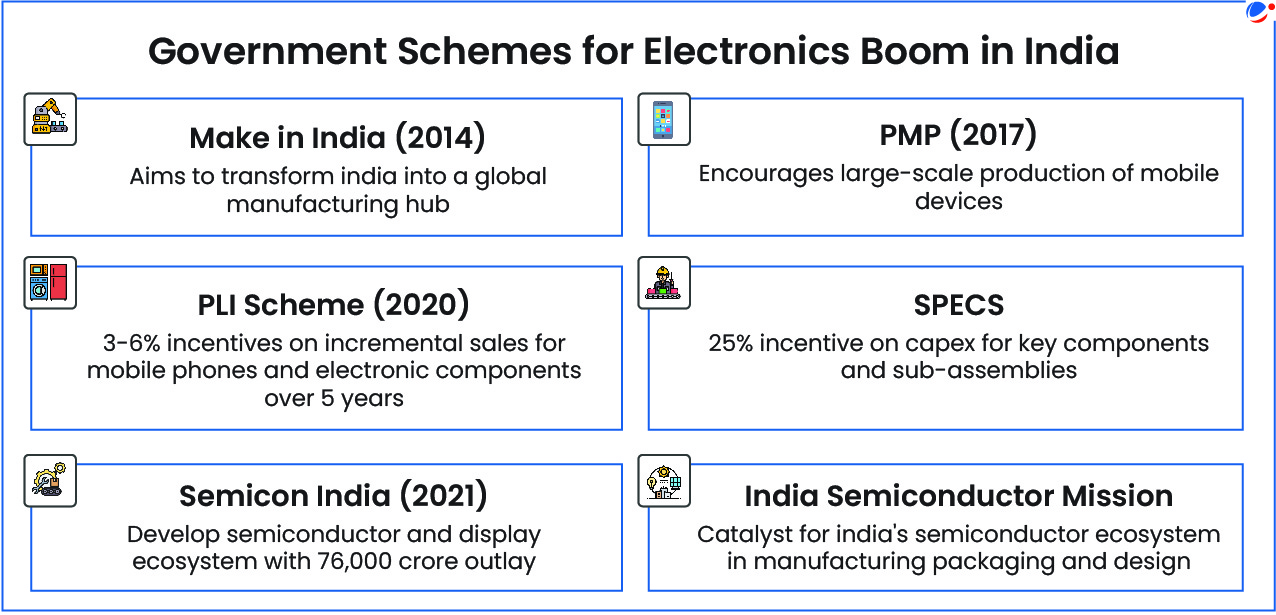Why in the News?
Ministry of Electronics and Information Technology notified the Electronics component manufacturing scheme.
About Electronics Component Manufacturing Scheme (ECMS)
- Ministry: Ministry of Electronics and Information Technology (MeiTY)
- Objective: To develop robust component manufacturing ecosystem by attracting investments (global/domestic) across the value chain by integrating its domestic electronic industry with the Global Value Chains (GVCs).
- Targeted Segments:
- Subassemblies (e.g. for display module and camera module)
- Bare Components (e.g. Multi-layer Printed Circuit Board etc.)
- Selected bare components (e.g. Flexible printed circuit board etc.),
- Supply chain ecosystem and capital equipment (e.g. Capital goods used in electronics manufacturing etc.)
- Types of Fiscal incentives offered for different segments:
- Turnover-linked (on incremental turnover/sales) for Sub-assemblies and Bare components
- Capex-linked (on eligible capital investment) for Supply chain ecosystem and capital equipment for electronics manufacturing
- Hybrid Incentive of both, based on industry needs for Selected bare components.
- Tenure:
- Turnover Linked Incentive: 6 years with one year of gestation period
- Capex Incentive: 5 years
- Eligibility: Greenfield as well as brownfield investment for the target segment shall be eligible under the scheme.
- Implementation agency: MeiTY through a nodal agency, which shall act as a Project Management Agency (PMA).
Significance of Electronic Components Sector India
- Economic Potential: The electronics industry is one of the fastest-growing sectors in India, with 5 times growth in Domestic production of electronic goods (FY2014-15 to FY2023-24).
- India's electronics sector is worth more than $150 billion today and by the end of this decade, the target is of $500 billion in production.
- Export Growth: The sector contributed $29.12 billion to India's total exports in FY24 with >20% Compound Average Growth Rate (CAGR) in exports of electronic goods (FY2014-15 to FY2023-24).
- National Security: Reliance on foreign electronics especially in defense, poses risks such as data breaches and supply chain disruptions.
- India's first ever national security semiconductor fabrication plant will be set up under India-US joint cooperation to produce chips for military hardware.
- Drives Technological Innovation in industries: E.g., 5G Technology Enabling Remote Surgery and Autonomous Vehicles.
Challenges faced by electronic component sector in India
- High cost of manufacturing: Multiple tariff slabs and surcharges, high material and logistics costs etc. make India's products globally uncompetitive.
- Tariffs and material costs result 4%-5% disadvantage for components compared to China due to the high cost of inputs.
- Scale up challenge: Scale up exists in manufacturing of low-complexity or locally produced components such as casings, glass, etc.
- Lack of R&D and design ecosystem: India spends less than 1% of GDP on R&D, far behind the USA and China (over 2.5%).
- Lack of access to global demand: Major global brands control 80% of the electronic market but most have not tapped India for exports.
- Heavy dependence on imports of Critical minerals: It exposes the sector to global supply chain disruptions and price volatility.
- Weak Component Ecosystem: Component production lags behind overall electronics growth due to high capex needs and has a lower turnover-to investment ratio, which makes current thresholds unattractive.
- Long Gestation Period: A gestation period of 1-2 years exists between investment and production in component manufacturing.
- Technological Challenges: Indian manufacturers currently lack the necessary technologies and skillsets for advanced electronics and components manufacturing, making technology transfer a critical need.

Way Forwar: Niti Aayog's Electronics: Powering India's Participation in Global Value Chains (GVCs)
- Fiscal Interventions
- Fiscal incentive for Components manufacturing:
- Opex support for scaling manufacturing of low complexity / locally produced components (non-SMT grade, casing, glass, etc.).
- Capex support for high-complexity components (Mechanics, capital goods, special components (SMD grade), Lithium-lon cells).
- Hybrid support for high-complexity components (SMD grade, 8 layer+ PCB passives etc.)
- Innovation scheme to promote SMEs/R&D centers of Indian firms to invest in product design and R&D.
- Develop large-size scaled clusters, provide Worker's housing facilities, Provision for localized regulations (e g., labor laws) and cluster governance etc.
- Fiscal incentive for Components manufacturing:
- Non-Fiscal Interventions
- Rationalize tariffs / duties on inputs to improve competitiveness of Finished Goods for exports
- Attract overseas high-level talent for high precision manufacturing and design through expedited visa approvals for training.
- Foster collaboration between academia & industry for advanced manufacturing and high-tech skills.
- Simplify the process of Tech transfer and fast track approvals required for components manufacturing.



